| Listing 1 - 10 of 16 | << page >> |
Sort by
|
Book
ISBN: 9781441966704 9781441966698 1441966692 Year: 2010 Publisher: New York NY Springer New York Imprint Springer
Abstract | Keywords | Export | Availability | Bookmark
 Loading...
Loading...Choose an application
- Reference Manager
- EndNote
- RefWorks (Direct export to RefWorks)
Since the first works introducing the aluminum intercalated clay family in the early 1970s, interest in the synthesis of pillared interlayered clays has increased tremendously, especially research into the properties and applications of new synthesis methods. The need for solids that could be used as cracking catalysts with larger pores than zeolitic materials has spurred the synthesis of new porous materials from clays. This book reviews the properties and applications of pillared clays and other layered materials used as catalysts, focusing on: - the acidity of pillared clays and the effect it has on catalytic performance - the use of pillared clays as supports for catalytically active phases, and the use of the resulting solids in environmentally friendly reactions - the comparison between the reactions of pillared clays and anionic clays.
Chemistry. --- Catalysis. --- Physical Chemistry. --- Inorganic Chemistry. --- Environmental Chemistry. --- Chemistry, inorganic. --- Physical organic chemistry --- Environmental chemistry. --- Chimie --- Chimie organique physique --- Catalyse --- Chimie de l'environnement --- Chemistry --- Chemistry, Inorganic --- Chemistry, Physical organic --- Catalysis --- Environmental chemistry
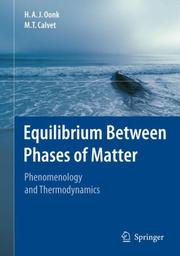
ISBN: 140206408X 1402061234 9048175429 9781402061233 9781402064081 Year: 2008 Publisher: Dordrecht : Springer Netherlands : Imprint: Springer,
Abstract | Keywords | Export | Availability | Bookmark
 Loading...
Loading...Choose an application
- Reference Manager
- EndNote
- RefWorks (Direct export to RefWorks)
The phase behaviour of materials and their thermodynamic properties are a central subject in all fields of materials research. The first Volume of the work, meant for graduate students in chemistry, geology, physics, and metallurgy, and their engineering counterparts, is split up in three levels, such that from level to level the portion and importance of thermodynamics and mathematics are increased. In the ground level it is shown that the basic principles of phase equilibria can be understood without the use of thermodynamics – be it that the concept of chemical potential is introduced right from the beginning. The intermediate level is an introduction to thermodynamics; culminating in the Gibbs energy as the arbiter for equilibrium – demonstrated for systems where the phases in equilibrium are pure substances. In the third level the accent is on binary systems, where one or more phases are solutions of the components. Explicit relationships between the variables are derived for equilibria involving ideal mixtures and ideal dilute solutions. Non-ideal systems are treated from three different angles – geometrically, analytically, and numerically. Throughout the work high priority is given to the thermodynamic assessment of experimental data; numerous end-of-chapter exercises and their solutions are included. The work is useful for scientists as an introduction and a reference book. Audience: Students, teachers, and scientists in chemistry, chemical engineering, geology and geophysics, metallurgy, and related branches of materials science.
Phase rule and equilibrium. --- Thermodynamics. --- Chemistry, Physical and theoretical --- Dynamics --- Mechanics --- Physics --- Heat --- Heat-engines --- Quantum theory --- Critical phenomena (Physics) --- Equilibrium --- Chemical equilibrium --- Chemical systems --- Critical point --- Chemistry, Physical organic. --- Materials. --- Geology. --- Physical geography. --- Physical Chemistry. --- Materials Science, general. --- Geophysics/Geodesy. --- Geography --- Geognosy --- Geoscience --- Earth sciences --- Natural history --- Engineering --- Engineering materials --- Industrial materials --- Engineering design --- Manufacturing processes --- Chemistry, Physical organic --- Chemistry, Organic --- Materials --- Physical chemistry. --- Materials science. --- Geophysics. --- Geological physics --- Terrestrial physics --- Material science --- Physical sciences --- Chemistry, Theoretical --- Physical chemistry --- Theoretical chemistry --- Chemistry
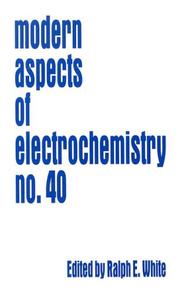
ISBN: 9780387461069 0387460993 9780387460994 1441923594 038746106X Year: 2007 Publisher: New York, NY : Springer New York : Imprint: Springer,
Abstract | Keywords | Export | Availability | Bookmark
 Loading...
Loading...Choose an application
- Reference Manager
- EndNote
- RefWorks (Direct export to RefWorks)
MODERN ASPECTS OF ELECTROCHEMISTRY No. 40 Edited by Ralph E. White University of South Carolina, Columbia, SC Topics in Number 40 include: Polymer Electrolyte Membrane (PEM) fuel cell bipolar plates, discussion of the difficulties associated with confronting bipolar plate development The use of graphs in electrochemical reaction networks with focus on analysis of variance (ANOVA) observation methods Nano-materials in lithium ion battery electrode design, presentation of a plasma-assisted method to create a carbon replica of an alumina template membrane Direct methanol fuel cells, extensive discussion and review of various types of fuel cells and advances made in the performance of DMFC’s since their inception Direct simulation of polymer electrolyte fuel cell catalyst layers, presentation of a systematic development of the direct numerical simulation From reviews of previous volumes: "This long-standing series continues its tradition of offering high quality reviews of established and emerging subject areas, together with the less common aspects of electrochemical science … Deserves a place in electrochemistry libraries and should prove useful to electrochemists and related workers." -Chemistry and Industry "Continues the valuable service that has been rendered by the Modern Aspects series." - Journal of Electroanalytical Chemistry "Will definitely be of much use to researchers in the field of electrochemistry… The editors of this well-produced volume deserve all appreciation for maintaining the excellent standard of the series." - Bulletin of Electrochemistry "Extremely well-referenced and very readable … Maintains the overall high standards of the series." - Journal of the American Chemical Society.
Chemistry. --- Electrochemistry. --- Physical Chemistry. --- Materials Science, general. --- Energy Technology. --- Catalysis. --- Physical organic chemistry --- Electric engineering. --- Materials. --- Chimie --- Chimie organique physique --- Catalyse --- Matériaux --- Chemistry --- Physical Sciences & Mathematics --- Physical & Theoretical Chemistry --- Physical chemistry. --- Electric power production. --- Materials science. --- Chemistry, Physical and theoretical --- Chemistry, Physical organic. --- Energy Systems. --- Activation (Chemistry) --- Surface chemistry --- Engineering --- Engineering materials --- Industrial materials --- Engineering design --- Manufacturing processes --- Chemistry, Physical organic --- Chemistry, Organic --- Physical sciences --- Materials --- Energy systems. --- Material science --- Chemistry, Theoretical --- Physical chemistry --- Theoretical chemistry
Book
ISBN: 9789400703100 9789400703117 9400703104 9400703112 Year: 2011 Publisher: Dordrecht : Springer Netherlands : Imprint: Springer,
Abstract | Keywords | Export | Availability | Bookmark
 Loading...
Loading...Choose an application
- Reference Manager
- EndNote
- RefWorks (Direct export to RefWorks)
Pierre Duhem (1861–1916) held the chair of theoretical physics at Bordeaux from 1894 to his death. He established a reputation in both the history and philosophy of science as well as in science itself (physics and physical chemistry). Much of his work in the first two areas has been translated into English, but little of his technical scientific work. The present volume contains early work of Duhem’s illustrating his interest in the rigorous development of physical theory for which he is famous. It opens with what was the first critical discussion of Gibbs’ groundbreaking "On the Equilibrium of Heterogeneous Substances" (1876-8), where Duhem addressed the problem that, as he put it, "Mathematicians regret that the principles of Thermodynamics should have been developed in general with so little precision that the same proposition can be regarded by some as a consequence, and by others as a negation, of these principles". The other papers, forming a three-part series, pursue this project of putting the foundations of thermodynamics on a clearer and more secure basis. This book will be of interest to scholars in history and philosophy of science, especially those interested in the development of physical chemistry and the work of Pierre Duhem.
Philosophy --- Theory of knowledge --- Philosophy of science --- History of physics --- Thermodynamics --- Physicochemistry --- thermodynamica --- filosofie --- epistomologie --- fysica --- fysicochemie --- Duhem, Pierre --- Thermodynamics. --- Duhem, Pierre Maurice Marie, --- Science --- Chemistry, Physical organic. --- Philosophy of Science. --- Physical Chemistry. --- History and Philosophical Foundations of Physics. --- Philosophy. --- Chemistry, Physical and theoretical --- Dynamics --- Mechanics --- Physics --- Heat --- Heat-engines --- Quantum theory --- Chemistry, Physical organic --- Chemistry, Organic --- Normal science --- Philosophy and science. --- Physical chemistry. --- Physics. --- Science and philosophy --- Natural philosophy --- Philosophy, Natural --- Physical sciences --- Chemistry, Theoretical --- Physical chemistry --- Theoretical chemistry --- Chemistry
Book
ISBN: 1282362526 9786612362521 3540708987 9783540708971 3540708979 9783540708988 364242547X Year: 2009 Publisher: Berlin, Heidelberg : Springer Berlin Heidelberg : Imprint: Springer,
Abstract | Keywords | Export | Availability | Bookmark
 Loading...
Loading...Choose an application
- Reference Manager
- EndNote
- RefWorks (Direct export to RefWorks)
The Science of Construction Materials is a study and work book for civil engineering students. Since the contents of the book are presented in a way that makes the reading an active process, the book is also suitable as self-study for the researcher and practising civil engineer. The publication is not a textbook on thermodynamics, but rather an incentive to use the calculation methods of physical chemistry to solve problems within the science of construction materials. The presentation of the theoretical subjects is supported by approximately 500 exercises with solutions as well as commented examples of calculations; throughout the book the relation to civil engineering practice is demonstrated. A detailed subject index and a comprehensive collection of tables of physical and chemical data for substances relevant for the science of construction materials are also found in the book. This makes the book suitable as a work of reference. "Many of the aspects of the deterioration of concrete infrastructure, such as corrosion of reinforcing steel, cannot be addressed until the underlying physics and chemistry are clearly understood. The textbook, Science of Construction Materials, is the first one in English that synthesizes various materials science issues, which are the foundation of our recent advances in infrastructure materials. An unusual and critically important aspect of the textbook is that it includes not only detailed concepts of thermodynamics and electrochemistry but also lays a mathematical foundation of computational models, which are necessary to tackle complex interactions between chemistry and mechanics. This book fills a much-needed gap in the scant literature available to students and researchers trying to learn the science of infrastructure materials." Surendra P. Shah, Walter P. Murphy Professor of Civil Engineering, Director of the Center for Advanced Cement Based Materials, Northwestern University .
Building materials. --- Building. --- Architectural materials --- Architecture --- Building --- Building supplies --- Buildings --- Construction materials --- Structural materials --- Materials --- Architectural engineering --- Construction --- Construction science --- Engineering, Architectural --- Structural design --- Structural engineering --- Construction industry --- Design and construction --- Building materials --- Materials science. --- Effect of temperature on. --- Civil engineering. --- Materials. --- Building construction. --- Chemistry, Physical organic. --- Civil Engineering. --- Materials Science, general. --- Structural Materials. --- Building Materials. --- Classical and Continuum Physics. --- Physical Chemistry. --- Chemistry, Physical organic --- Chemistry, Organic --- Chemistry, Physical and theoretical --- Engineering --- Engineering materials --- Industrial materials --- Engineering design --- Manufacturing processes --- Public works --- Structural materials. --- Continuum physics. --- Physical chemistry. --- Chemistry, Theoretical --- Physical chemistry --- Theoretical chemistry --- Chemistry --- Classical field theory --- Continuum physics --- Physics --- Continuum mechanics --- Material science --- Physical sciences
Book
ISSN: 03401022 ISBN: 9783540778691 3540778683 9783540778684 3540778691 Year: 2008 Volume: 284 Publisher: Berlin, Germany : Springer,
Abstract | Keywords | Export | Availability | Bookmark
 Loading...
Loading...Choose an application
- Reference Manager
- EndNote
- RefWorks (Direct export to RefWorks)
Biomolecules in nature exhibit overwhelming one-handedness, often called homochirality, such as L-amino acids and D-sugars. Since the discovery of molecular chirality by Pasteur, the origins of chirality and the process le- ing to enantiopure biomolecules have attracted broad attention from many researchers. Several theories have been proposed for the origin of chirality in organic compounds, for example, left and right-circularly polarized light, sp- taneous absolute asymmetric synthesis, and chiral inorganic crystals such as quartz. However, the enantioenrichments induced by these mechanisms have been very low or even below detection levels. Thus, the process of ampli?cation of enantioenrichment is inevitable to reach enantiopure compounds. In 1953, Frank proposed a mechanism of asymmetric autocatalysis without mentioning any chemical structure. However, it then took over 40 years for us to discover asymmetric autocatalysis with ampli?cation of chirality in 1995. This book illustrates the recent aspects of ampli?cation of chirality by as- metric autocatalysis and by forming helical structures. The ?rst four chapters summarize experimental asymmetric autocatalysis with ampli?cation of en- tiopurity, the mechanism of asymmetric autocatalysis examined by NMR and calculation, the computer simulation models of the reaction mechanism of asymmetric autocatalysis, and the theoretical models of ampli?cation of c- rality. The last chapter deals with the ampli?cation of chirality by the f- mation of helical structures. However, the ampli?cation of enantiopurity in non-autocatalytic asymmetric reaction and the ampli?cation by enantiomer separation involving crystallization or sublimation are beyond the scope of this book.
Chemistry. --- Organic Chemistry. --- Organometallic Chemistry. --- Physical Chemistry. --- Chemistry, Organic. --- Physical organic chemistry --- Chimie --- Chimie organique --- Chimie organique physique --- Circular Dichroism --- Stereoisomerism --- Isomerism --- Spectrum Analysis --- Chemistry Techniques, Analytical --- Organic Chemistry Phenomena --- Investigative Techniques --- Chemical Phenomena --- Phenomena and Processes --- Analytical, Diagnostic and Therapeutic Techniques and Equipment --- Biochemistry --- Physical & Theoretical Chemistry --- Chemistry --- Physical Sciences & Mathematics --- Autocatalysis. --- Chirality. --- Autocatalytic reaction --- Reaction, Autocatalytic --- Self-catalysis --- Organic chemistry. --- Organometallic chemistry. --- Physical chemistry. --- Stereochemistry --- Symmetry (Physics) --- Enantiomers --- Catalysis --- Chemistry, Physical organic. --- Chemistry, Physical organic --- Chemistry, Organic --- Chemistry, Physical and theoretical --- Organic chemistry --- Organometallic chemistry . --- Chemistry, Theoretical --- Physical chemistry --- Theoretical chemistry --- Chemistry, Organometallic --- Metallo-organic chemistry --- Stereoisomerism.
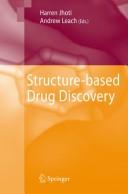
ISBN: 9781402044076 1402044070 1280902477 9786610902477 1402044070 Year: 2007 Publisher: Dordrecht : Springer Netherlands : Imprint: Springer,
Abstract | Keywords | Export | Availability | Bookmark
 Loading...
Loading...Choose an application
- Reference Manager
- EndNote
- RefWorks (Direct export to RefWorks)
Discovering new medicines is becoming more challenging and the pharmaceutical industry is looking to new technologies to help in this mission. Structure-based drug discovery methods have been transformed in the last 5-10 years and are now having a major impact on the discovery of new drugs. Some of the most exciting developments in the field, such as Fragment-based methods, are described in this book. Structure-based drug discovery describes the latest developments in technologies that can be used to obtain the 3-D structures including the high profile structural genomics approaches being used worldwide. The use of 3-D protein structures in new, Fragment-based, approaches to drug discovery are described in some detail. This book includes experimental approaches using X-ray crystallography and NMR for Fragment-based screening as well as other biophysical methods for studying protein/ligand interactions. In addition, developments in computational chemistry methodology are covered together with an assessment of practical applications. This book is an invaluable resource for medicinal chemists in industry, computational chemists, drug discovery scientists and postgraduates in chemistry or structural biology.
chemie --- General biochemistry --- Computer. Automation --- Clinical chemistry --- biochemie --- medische chemie --- Chemistry --- fysicochemie --- farmacologie --- Physicochemistry --- Pharmacology. Therapy --- Biochemistry. --- Medicine. --- Toxicology. --- Pharmacy. --- Chemistry, Physical organic. --- Medicinal Chemistry. --- Biomedicine general. --- Pharmacology/Toxicology. --- Biochemistry, general. --- Physical Chemistry. --- Medicine --- Drugs --- Materia medica --- Pharmacology --- Chemicals --- Poisoning --- Poisons --- Chemistry, Physical organic --- Chemistry, Organic --- Chemistry, Physical and theoretical --- Clinical sciences --- Medical profession --- Human biology --- Life sciences --- Medical sciences --- Pathology --- Physicians --- Biological chemistry --- Chemical composition of organisms --- Organisms --- Physiological chemistry --- Biology --- Toxicology --- Composition --- Health Workforce --- Medicinal chemistry. --- Pharmacology. --- Physical chemistry. --- Biomedicine, general. --- Drug effects --- Medical pharmacology --- Chemotherapy --- Pharmacy --- Chemistry, Medical and pharmaceutical --- Chemistry, Pharmaceutical --- Drug chemistry --- Medical chemistry --- Medicinal chemistry --- Pharmacochemistry --- Chemistry, Theoretical --- Physical chemistry --- Theoretical chemistry --- Physiological effect
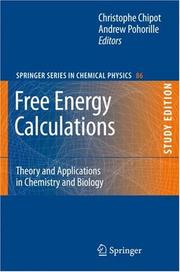
ISSN: 01726218 ISBN: 9783540384489 9783540736172 3540736174 1280745339 9786610745333 3540384472 3540384480 Year: 2007 Volume: v. 86 Publisher: Berlin, Heidelberg : Springer Berlin Heidelberg : Imprint: Springer,
Abstract | Keywords | Export | Availability | Bookmark
 Loading...
Loading...Choose an application
- Reference Manager
- EndNote
- RefWorks (Direct export to RefWorks)
Free energy constitutes the most important thermodynamic quantity to understand how chemical species recognize each other, associate or react. Examples of problems in which knowledge of the underlying free energy behaviour is required, include conformational equilibria and molecular association, partitioning between immiscible liquids, receptor-drug interaction, protein-protein and protein-DNA association, and protein stability. This volume sets out to present a coherent and comprehensive account of the concepts that underlie different approaches devised for the determination of free energies. The reader will gain the necessary insight into the theoretical and computational foundations of the subject and will be presented with relevant applications from molecular-level modelling and simulations of chemical and biological systems. Both formally accurate and approximate methods are covered using both classical and quantum mechanical descriptions. A central theme of the book is that the wide variety of free energy calculation techniques available today can be understood as different implementations of a few basic principles. The book is aimed at a broad readership of graduate students and researchers having a background in chemistry, physics, engineering and physical biology.
chemie --- Numerical analysis --- Computer. Automation --- algoritmen --- Statistical physics --- informatica --- Atomic physics --- Plasma physics --- Chemistry --- numerieke analyse --- General biophysics --- plasmafysica --- fysicochemie --- biofysica --- statistiek --- Physicochemistry --- fysica --- Gibbs' free energy --- Thermodynamics --- Thermodynamique --- General and Others --- Chemistry. --- Physical chemistry. --- Chemistry, Physical and theoretical. --- Physics. --- Atoms. --- Biophysics. --- Biological physics. --- Statistical physics. --- Dynamical systems. --- Theoretical and Computational Chemistry. --- Physical Chemistry. --- Numerical and Computational Physics. --- Statistical Physics, Dynamical Systems and Complexity. --- Atomic, Molecular, Optical and Plasma Physics. --- Biophysics and Biological Physics. --- Linear free energy relationship --- Computer simulation. --- Physical sciences --- Correlation analysis (Chemistry) --- Correlation equation (Chemistry) --- Free energy relationship, Linear --- Chemical reaction, Conditions and laws of --- Chemistry, Physical organic. --- Numerical and Computational Physics, Simulation. --- Complex Systems. --- Biological and Medical Physics, Biophysics. --- Chemistry, Physical organic --- Chemistry, Organic --- Chemistry, Physical and theoretical --- Biological physics --- Biology --- Medical sciences --- Physics --- Matter --- Stereochemistry --- Dynamical systems --- Kinetics --- Mathematics --- Mechanics, Analytic --- Force and energy --- Mechanics --- Statics --- Mathematical statistics --- Natural philosophy --- Philosophy, Natural --- Dynamics --- Chemistry, Theoretical --- Physical chemistry --- Theoretical chemistry --- Constitution --- Statistical methods
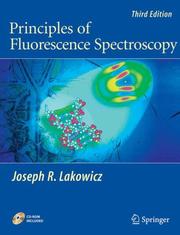
ISBN: 0387312781 9780387312781 0387463127 9780387463124 Year: 2006 Publisher: New York, NY : Springer US : Imprint: Springer,
Abstract | Keywords | Export | Availability | Bookmark
 Loading...
Loading...Choose an application
- Reference Manager
- EndNote
- RefWorks (Direct export to RefWorks)
Principles of Fluorescence Spectroscopy, 3rd edition , 3rd edition Joseph R. Lakowicz The third edition of the established classic text reference, Principles of Fluorescence Spectroscopy, will enhance upon the earlier editions' successes. Organized as a textbook for the learning student or the researcher needing to acquire the core competencies, Principles of Fluorescence Spectroscopy, 3e will maintain the emphasis on basics, while updating the examples to include recent results from the literature. The third edition also includes new chapters on single molecule detection, fluorescence correlation spectroscopy, novel probes and radiative decay engineering. This full-color textbook features the following: Problem sets following every chapter Glossaries of commonly used acronyms and mathematical symbols Appendices containing a list of recommended books which expand on various specialized topics Sections describing advanced topics will indicate as such, to allow these sections to be skipped in an introductory course, allowing the text to be used for classes of different levels Includes CD-ROM of all figures in a low-res format, perfect for use in instruction and presentations Principles of Fluorescence Spectroscopy, 3rd edition, is an essential volume for students, researchers, and industry professionals in biophysics, biochemistry, biotechnology, bioengineering, biology and medicine. About the Author: Dr. Joseph R. Lakowicz is Professor of Biochemistry at the University of Maryland School of Medicine, Baltimore, and Director of the Center for Fluorescence Spectroscopy. Dr. Lakowicz has published over 400 scientific articles, has edited numerous books, holds 16 issued patents, and is the author of the widely used text, Principles of Fluorescence Spectroscopy now in its 3rd edition. .
Theoretical spectroscopy. Spectroscopic techniques --- fysicochemie --- Fluorescence spectroscopy. --- Spectroscopie de fluorescence --- Fluorescence spectroscopy --- Analytical Chemistry --- Chemistry --- Physical Sciences & Mathematics --- Basic Sciences. Biology --- Biological Techniques --- 535.372 --- Fluorescence spectrometry --- Spectrometry, Fluorescence --- Spectroscopy, Fluorescence --- Luminescence spectroscopy --- Fluorescent probes --- Fluorescence spectra --- Biological Techniques. --- 535.372 Fluorescence spectra --- EPUB-LIV-FT LIVCHIMI SPRINGER-B --- Chemistry. --- Analytical chemistry. --- Mass spectrometry. --- Biotechnology. --- Physical chemistry. --- Biochemistry. --- Biophysics. --- Biological physics. --- Mass Spectrometry. --- Analytical Chemistry. --- Biophysics and Biological Physics. --- Biochemistry, general. --- Physical Chemistry. --- Analytical biochemistry. --- Chemistry, Physical organic. --- Biological and Medical Physics, Biophysics. --- Chemistry, Physical organic --- Chemistry, Organic --- Chemistry, Physical and theoretical --- Chemical engineering --- Genetic engineering --- Biological chemistry --- Chemical composition of organisms --- Organisms --- Physiological chemistry --- Biology --- Medical sciences --- Analytic biochemistry --- Biochemistry --- Chemistry, Analytic --- Mass spectra --- Mass spectrograph --- Mass spectroscopy --- Mass spectrum analysis --- Mass (Physics) --- Nuclear spectroscopy --- Spectrum analysis --- Composition --- Bioanalytic chemistry --- Bioanalytical chemistry --- Analytical chemistry --- Biological physics --- Physics --- Analysis, Chemical --- Analytic chemistry --- Chemical analysis --- Chemistry, Theoretical --- Physical chemistry --- Theoretical chemistry
Book
ISBN: 9783642034329 9783642034312 3642034314 364203540X 3642034322 Year: 2009 Publisher: Berlin, Heidelberg : Springer Berlin Heidelberg : Imprint: Springer,
Abstract | Keywords | Export | Availability | Bookmark
 Loading...
Loading...Choose an application
- Reference Manager
- EndNote
- RefWorks (Direct export to RefWorks)
The Jahn-Teller effect continues to be a paradigm for structural instabilities and dynamical processes in molecules and in the condensed phase. Among the many important newer developments in the field one should mention cooperative phenomena in crystals, the general importance of pseudo-Jahn-Teller couplings for symmetry-lowering phenomena in molecular systems, non-adiabatic processes at conical intersections of potential energy surfaces and extensions of the basic theory in relation to the discovery of fullerenes and other icosahedral systems. Written by leading international experts the aim of the present volume is to provide a survey of the state-of-the art in Jahn-Teller interactions at the interface of quantum chemistry and condensed matter physics, addressing both the non-expert scientist as well as those experts interested in expanding their knowledge into neighboring areas. Cast in form of a set of extensive and tutorial reviews – and thus suitable as a complement to available textbooks in the field – the following topics are dealt with in this book: - Jahn-Teller effect and vibronic interactions: General theory - Conical intersections and nonadiabatic dynamics in molecular processes - Impurities; Spectroscopy of transition metal complexes - Fullerenes and fullerides - Jahn-Teller effect and molecular magnetism - The cooperative Jahn-Teller effect and orbital ordering - Jahn-Teller effect and high-Tc Superconductivity.
Chemistry. --- Physical Chemistry. --- Solid State Physics. --- Spectroscopy and Microscopy. --- Theoretical and Computational Chemistry. --- Atomic/Molecular Structure and Spectra. --- Physical organic chemistry --- Chimie --- Chimie organique physique --- Jahn-Teller effect --- Jahn-Teller, Effet --- Jahn-Teller effect. --- Physics. --- Natural philosophy --- Philosophy, Natural --- Teller-Jahn effect --- Chemical structure --- Electronics and optics of solids --- Chemistry --- fysicochemie --- Molecular physics --- Physicochemistry --- Physics --- Physical chemistry. --- Chemistry, Physical and theoretical. --- Atomic structure. --- Molecular structure. --- Spectra. --- Solid state physics. --- Spectroscopy. --- Microscopy. --- Physical sciences --- Dynamics --- Coupled mode theory --- Crystal field theory --- Energy levels (Quantum mechanics) --- Chemistry, Physical organic. --- Chemistry, Physical organic --- Chemistry, Organic --- Chemistry, Physical and theoretical --- Jahn-Teller, Effet. --- Atomic structure . --- Molecular structure . --- Structure, Molecular --- Structural bioinformatics --- Structure, Atomic --- Atomic theory --- Chemistry, Theoretical --- Physical chemistry --- Theoretical chemistry --- Analysis, Microscopic --- Light microscopy --- Micrographic analysis --- Microscope and microscopy --- Microscopic analysis --- Optical microscopy --- Optics --- Analysis, Spectrum --- Spectra --- Spectrochemical analysis --- Spectrochemistry --- Spectrometry --- Spectroscopy --- Chemistry, Analytic --- Interferometry --- Radiation --- Wave-motion, Theory of --- Absorption spectra --- Light --- Spectroscope --- Solids --- Qualitative --- Analytical chemistry
| Listing 1 - 10 of 16 | << page >> |
Sort by
|

 Search
Search Feedback
Feedback About
About Help
Help News
News